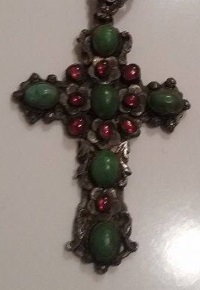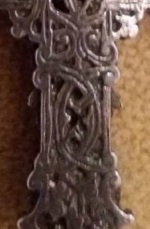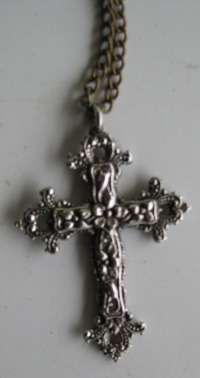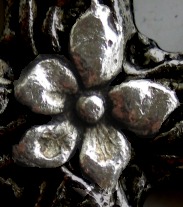Rose of Sharon Cross
It is interesting in that it merges a symbol of the Old Testament (the Rose of Sharon) with a symbol of the New Testament (the cross).
Both symbols mean beauty and love.
The Rose of Sharon, although apparently written about in the Bible perhaps 3,000 years ago, has paradoxically only been around for approximately 400 years.
When the King James Bible was compiled in 1611, it seems the Hebrew 'chabatstseleth', meaning 'crocus', was mistranslated as 'rose'. Quite possibly the original author meant 'gladioli' or 'tulip', which grew profusely in the forest plain of Sharon. (Not so many wild flowers there these days - Sharon is now the most densely populated region of Israel.)
But 'Crocus of Sharon' just doesn't sound right and as everyone knows, tulips come from Amsterdam. So 'Rose of Sharon' stays, even if it isn't botanically correct.
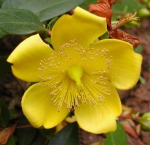
Hypericum calycinum
The name is given to several different plants, the most common being Hibiscus syriacus and the unrelated Hypericum calycinum. The former is the national flower of South Korea, called mugunghwa, which stems from the word mugung, meaning 'immortality'. In Korea, this flower is symbolic of the royal family; just as the rose has been used by monarchies around the world for centuries. Indeed, when the King James Bible was being compiled, the monarch used the Tudor Rose within his emblem. One wonders whether the Bible's English translators were influenced by this regal connection when re-writing King Solomon's words.
Roses are favoured by lovers. It is no surprise that in the USA, 34% of the annual sale of roses coincides with Valentine's Day (which includes our favourite little story about roses.)
Roses can be used as a Vitamin C supplement in herbal tea; not the petals but the reddish / orange pomaceous fruit (the rose hip). A similar herb is St. John's Wort.
(We don't know if St. John the Evangelist had warts!)
The word 'wort' is from the Old English wyrt, meaning root or herb. St. John's Wort is today used as an herbal treatment for depression, but increasingly there is concern of the wort's adverse effects, especially when taken with other pharmaceuticals. See the scary 'St John's Wort Interactions Table' at herbological.com/....

Evangelical Lutheran Church in Southern Africa logo with a Jerusalem Cross in a 5-petalled Lutheran Rose
(Click image to enlarge)
Thus far, we have connected the rose to immortality, royalty, love and medicine... before we even look at what the book of Solomon says.
The Rose of Sharon in Solomon 2 is used to describe the beauty of a young woman and the love toward her. This is understood by Jews to allegorically represent the 'husband and wife' relationship between God and Israel. Christians similarly understand it as the relationship between Christ and the Church, or with focus on the femininity, Marian. And from here we move on to the Rose of Sharon Cross.
Whilst Christian theologians might consider the 'rose' to be a figurative reference to the Church or the Virgin Mary, hymn writers have confused the issue by calling Jesus the Rose of Sharon. One reason might have been that after the Protestant Reformation, attempts were made to focus more on Jesus and less on His Mother. The rose happens to be a beautiful flower, and since Jesus Christ is tops when it comes to spiritual beauty and majesty, referring to Jesus as the Rose of Sharon is not entirely mysterious. Rose hips are associated with medicinal healing, and Christ's spiritual healing properties were the very reason for Jesus coming to earth 2,000 years ago.
The five petals on the Rose of Sharon remind us of the five wounds of Passion Jesus suffered on the cross. And of course, Christ rose from death, a pun which reminds us of the meaning of the Cross.
The photo of the antique Rose of Sharon Cross on the left was sent to us from a lady in Iceland.
On its reverse we see Celtic swirls, consistent with the country's heritage. (Click any photo to enlarge.)
The semi-precious stones of ruby and jade are not understood to have any special significance, since they are not native to the Holy Land. They do, however, have the obvious colour correlation of red for the blood shed by Christ on the Cross and symbolic of Salvation, and green being symbolic of new growth and everlasting life.
It's interesting how the red/green colours, being complementary positions on the colour wheel, have the complementary symbolism of death and life as illustrated by this cross.
There are six jade stones, which happens to match the number of "days" taken by God to create the world for us. We do not know whether that meaning was intended in the design of this cross. Similarly we do not know whether the nine rubies relate to the nine orders of Angels referred to in the Bible. As with all crosses and symbols, it is easy to let imagination replace fact. However, if you have any authoritative information to add about this particular cross, please email us and we'll pass your message to its owner.
Our Rose of Sharon Cross drawing shown at the very top of this page has been copied from a pendant unearthed by a young girl several years ago. The original owner of this treasure is a mystery; the girl found it in the garden of her home, a house that her father had built on virgin land. The cross appears to be Victorian and made from a mixture of silver and pewter, a traditional alloy for Celtic jewellery.
The chain is quite long (880 mm) and the cross is rather weighty (63 g with the chain) and large (75 mm x 55 mm x 6 mm). This makes the piece more like a ceremonial / religious Pectoral Cross than simply a piece of decorative jewellery. The floral design is on both back and front of the cross. (If anybody recognises this as a cross from a particular religious order, please email us.)
A distinctive five-petalled Rose of Sharon can be seen in the centre, plus tulip-shaped Rose of Sharon buds, symbolising new birth, and by extension, the resurrection of Christ. The fleur de lis at the cross arm ends are quite unique, with its lily petals arranged like feather plumes, as a chieftain would wear, and they form a crown, making it all very majestic. This, of course, symbolizes Christ the King.
We mentioned earlier the Rose association with Mary and we end this tale of the young girl's cross with a little twist:
The name of the girl is Rosemary.
See also Rose Cross
A mistranslation, according to the translation committee of the Bible's New Revised Standard Version.
Crocus (noun): A circus for crows? Maybe. They are often seen practising tight-rope walking on overhead power cables. And with NO SAFETY NET! Unbelievable!
See also Christmas colours

